The AMD Radeon R9 Nano Review: The Power of Size
by Ryan Smith on September 10, 2015 8:00 AM ESTCompute
Shifting gears, we have our look at compute performance.
Starting us off for our look at compute is LuxMark3.0, the latest version of the official benchmark of LuxRender 2.0. LuxRender’s GPU-accelerated rendering mode is an OpenCL based ray tracer that forms a part of the larger LuxRender suite. Ray tracing has become a stronghold for GPUs in recent years as ray tracing maps well to GPU pipelines, allowing artists to render scenes much more quickly than with CPUs alone.
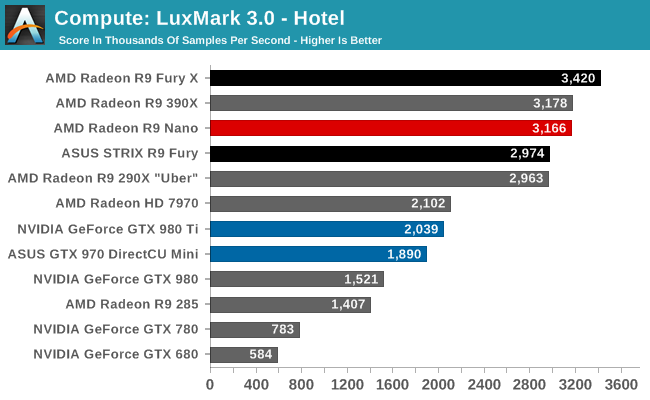
LuxMark ends up being a great corner case for where having a fully enabled Fiji GPU is more important than having the highest clockspeeds. With the R9 Nano able to flirt with its full 1000MHz clockspeed here, the card is able to pass the R9 Fury here. The only thing stopping it from taking the second-place spot is the R9 390X, as Hawaii still sees strong performance here even with fewer SPs.
For our second set of compute benchmarks we have CompuBench 1.5, the successor to CLBenchmark. CompuBench offers a wide array of different practical compute workloads, and we’ve decided to focus on face detection, optical flow modeling, and particle simulations.
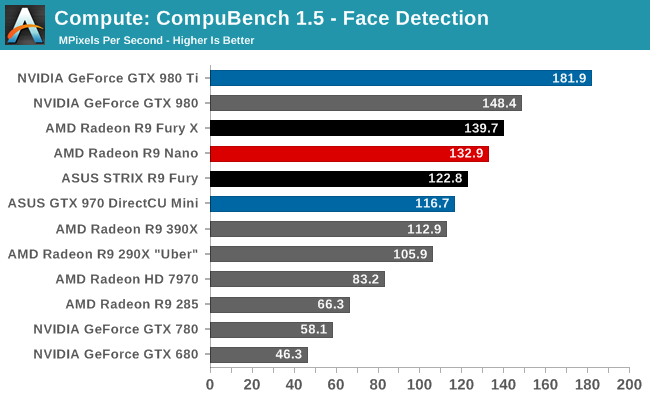
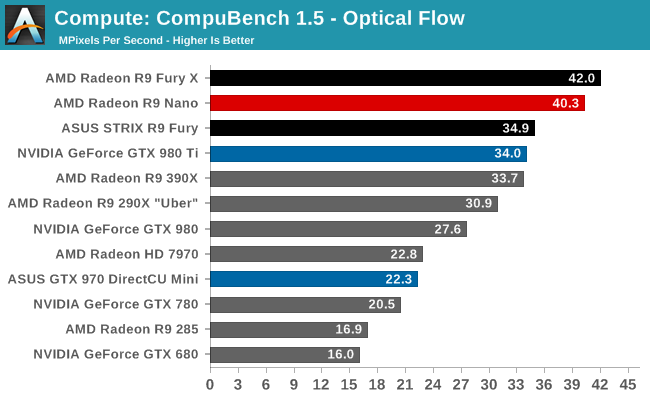
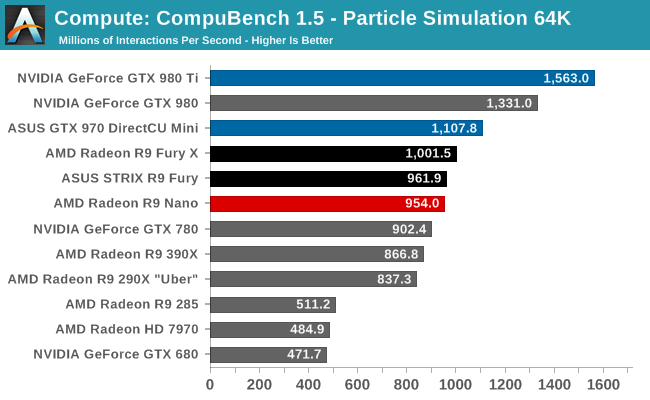
CompuBench provides us another case of where the R9 Nano ends up outpacing the R9 Fury. As a result AMD’s latest card tends to perform somewhere between an R9 Fury and R9 Fury X, with all of the strengths and weaknesses that come from that. This puts the R9 Nano in a good place for Optical Flow, while it will still trail NVIDIA”s best cards under Face Detection and the 64K particle simulation.
Meanwhile it’s interesting to note that AMD’s particle sim scores have significantly improved in the recent drivers. GCN 1.2 cards have seen 20%+ performance improvements here, which may point to some new OpenCL compiler optimizations from AMD.
Our 3rd compute benchmark is Sony Vegas Pro 13, an OpenGL and OpenCL video editing and authoring package. Vegas can use GPUs in a few different ways, the primary uses being to accelerate the video effects and compositing process itself, and in the video encoding step. With video encoding being increasingly offloaded to dedicated DSPs these days we’re focusing on the editing and compositing process, rendering to a low CPU overhead format (XDCAM EX). This specific test comes from Sony, and measures how long it takes to render a video.
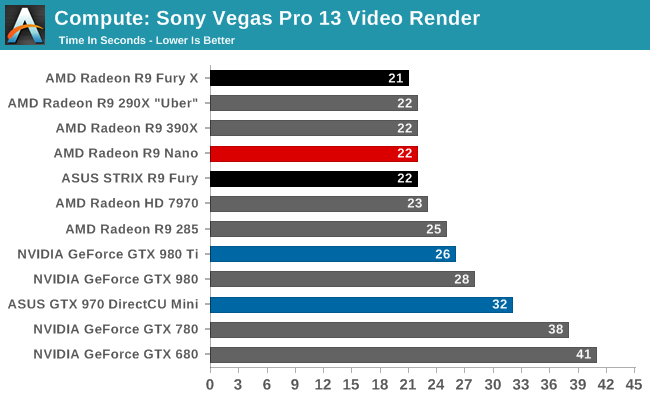
With Vegas there are no surprises; the R9 Nano ties the R9 Fury.
Moving on, our 4th compute benchmark is FAHBench, the official Folding @ Home benchmark. Folding @ Home is the popular Stanford-backed research and distributed computing initiative that has work distributed to millions of volunteer computers over the internet, each of which is responsible for a tiny slice of a protein folding simulation. FAHBench can test both single precision and double precision floating point performance, with single precision being the most useful metric for most consumer cards due to their low double precision performance. Each precision has two modes, explicit and implicit, the difference being whether water atoms are included in the simulation, which adds quite a bit of work and overhead. This is another OpenCL test, utilizing the OpenCL path for FAHCore 17.

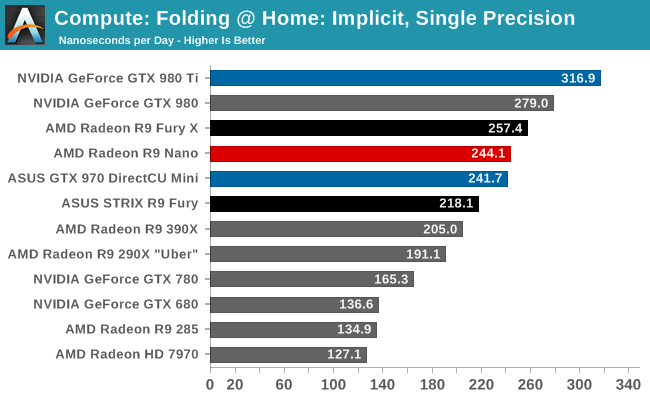
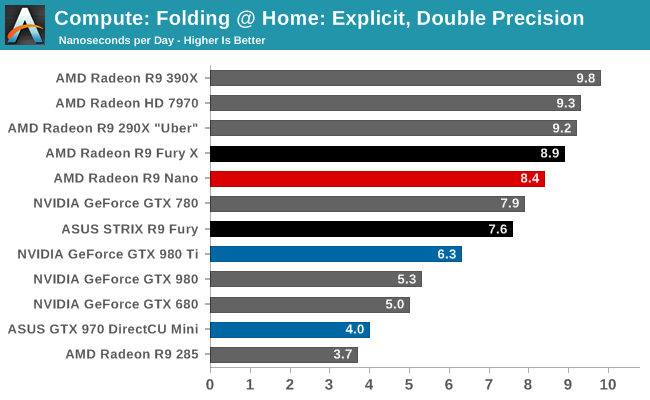
Much like CompuBench and LuxMark, the R9 Nano punches above its weight here. The lack of a graphics workload – and resulting demands on graphics hardware like the ROPs – means most of the card’s power can be allocated to the shaders, allowing higher clockspeeds. This gives the Nano a boost in this situation to bring it much closer to the Fury X, though as far as Folding goes AMD will still trail NVIDIA’s best cards.
Wrapping things up, our final compute benchmark is an in-house project developed by our very own Dr. Ian Cutress. SystemCompute is our first C++ AMP benchmark, utilizing Microsoft’s simple C++ extensions to allow the easy use of GPU computing in C++ programs. SystemCompute in turn is a collection of benchmarks for several different fundamental compute algorithms, with the final score represented in points. DirectCompute is the compute backend for C++ AMP on Windows, so this forms our other DirectCompute test.

Our final test sees the R9 Nano brought back to its place behind the R9 Fury, as the C++ AMP sub-tests are strenuous enough to cause more significant clockspeed throttling. Even behind the R9 Fury the R9 Nano does well for itself here, coming in behind the GTX 980 Ti and head of the R9 390X and GTX 980.










284 Comments
View All Comments
Jm09 - Friday, September 11, 2015 - link
Yes I'm aware, but the nano is binned for the highest quality chips. I wish they would of released two models where one was clocked lower and didn't have binned chips. That alone increased the price of this chipMaddyScientist - Thursday, September 10, 2015 - link
It would be nice to use the latest version of LuxMark 3.1, as this has optimizations for both AMD and NVIDIA GPUs, that makes it run faster on more recent GPUs. This would would give a better picture of the compute benefits of these new GPUS.at80eighty - Friday, September 11, 2015 - link
Ryan, i realise it's a test bench, but that cable management is making me twitchy :)Ryan Smith - Friday, September 11, 2015 - link
Noted and agreed. It wasn't really built for public display, it was thrown together for video recording. Small computers are nice, but they're hard to quickly route cables in, especially with my giant hands.awstar - Friday, September 11, 2015 - link
Review > Compute > Vegas: The Vegas benchmark has peaked. The reviewers should post stats on timeline playback performance, or upgrade the test file to 4K XAVC 32-bit float project levels. This would show a much greater difference between the modern GPUs.Haravikk - Friday, September 11, 2015 - link
It's great to see a card like this; finally a proper high end for half-length cards. While there are some good Mini-ITX cases that can take full-length cases, they end up so long that it kind of defeats the point of building small, but half-length cards are usually more in the budget to mid-range bracket, or a generation behind, either way it means a big sacrifice in going small.Hopefully we'll see more competition in this case, as I'm one of those who, in going small, is fine with paying a premium to still remain fairly competitive while doing so.
Regarding the idle noise level though; I still find it weird that there isn't better support out there for switching from integrated to discrete GPUs. Since most people still favour Intel processors this would make a lot of sense given that they have integrated graphics, plus in the Mini-ITX size on the AMD side it can be more cost effective to get an APU anyway. If the integrated GPU could take over for desktop stuff, browsing etc. like we see on laptops, then it would leave the Nano to just function as a set of video interfaces, which would be much better.
Alternatively, I wonder if they could even just add an APU type GPU as a low-power alternative onto the card; i.e- with a light load and low VRAM requirements it would take over and just use some low cost RAM (or even system RAM) so that the rest of the card can be shut off entirely.
Peichen - Friday, September 11, 2015 - link
Modern graphic card only draws single-digit watt power at idle/2D so the whole hybrid GPU idea was dropped. Routing video through integrated GPU also reduce performance by 2-3% and taken into account the complexity involved with driver just to save 8w makes no sense.atomsymbol - Friday, September 11, 2015 - link
R9 Nano: 4096 SP, 1 GHz, 512 GB/s => x+5 FPS, price y+$220R9 390X: 2816 SP, 1.05 GHz, 384 GB/s => x FPS, price y
+35% computational power => +5 FPS
Mathos - Friday, September 11, 2015 - link
After having read this review. All I can really think of to say about the Nano, is they should of priced it at least the same as the regular R9 Fury. That way you'd easily get GTX 980 performance in a itx form factor, for close to the same price. I must say your review seems a bit more fair than Toms hardware. Somehow they had a regular 980 outperforming the FuryX, so I was like wth Toms.I personally had been waiting for the Nano reviews to come out, before deciding what to get. But going by the price, it looks like I'll be getting an R9 Fury, so I can run most games in VSR 1440p, scaled down to 1080p. Either that or I'll just cap my fps at 65 and save power. Should do well once more DX12 games come out too.
itproflorida - Friday, September 11, 2015 - link
you have no idea what your talking about its all speculation. thank you